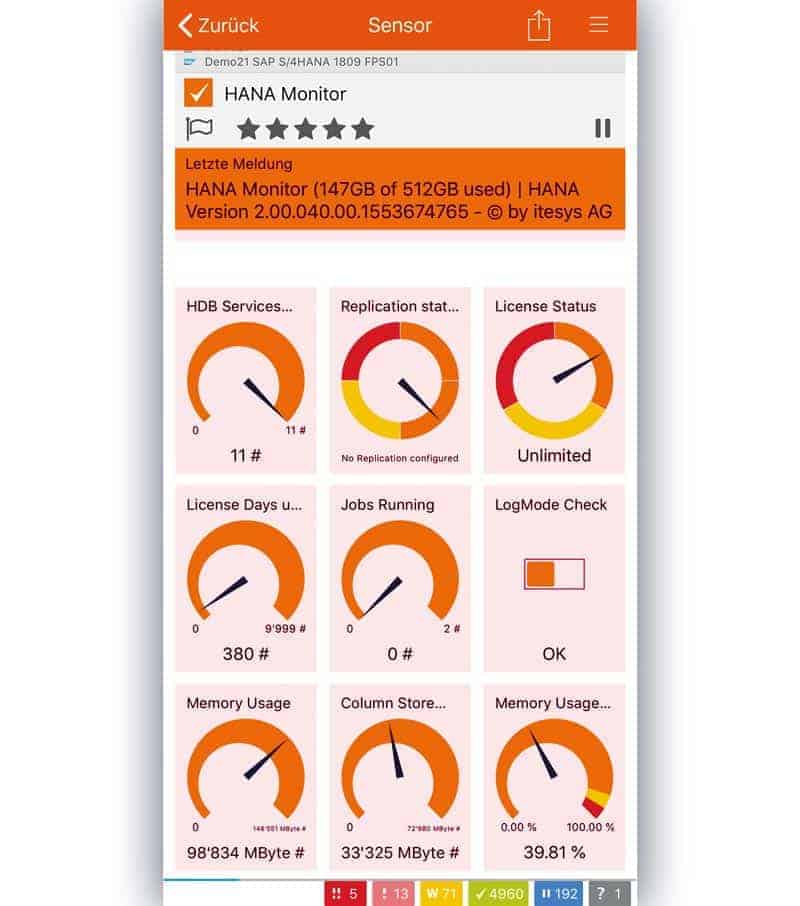Automatic monitoring with agentless SAP sensors


You don't have to be a CIO or CFO to see that a lot of time and money can be saved with automated SAP monitoring that detects and reports problems in real time.
An interesting approach in this direction are the agentless SAP sensors from the Swiss SAP Basis specialist Itesys, which are integrated as add-ons into the popular monitoring tool PRTG.
In view of the enormous costs caused by an SAP system that is at a standstill or not running smoothly, it is surprising that the topic of SAP monitoring is treated stepmotherly in many companies.
More urgent strategic projects, tight budgets and limited personnel resources are often cited as reasons. This is also surprising, because experience shows that professional, highly automated SAP monitoring is one of the most effective ways to save time and costs in IT.
Professional SAP monitoring must detect faults and bottlenecks at an early stage. For example, when hard disk space is running low or errors have occurred during system updates.
The latter can have a direct impact on the SAP system, for example by blocking or slowing down user processes, dialog or background jobs. Real-time warning is essential here so that the faults can be rectified before they affect operations.
Efficient monitoring also makes it easy to keep an eye on decentralized SAP system locations and collect reliable data for trend analyses and system optimization.

SAP on-board resources reach their limits
Practical experience shows that SAP on-board tools such as the Computer Center Management System (CCMS) reach their limits at an early stage, especially if hardware, operating system level, databases and peripheral systems are also to be included in the monitoring.
Open source solutions offer more options in this respect in some cases, but are often complex to operate and administer and require special expert knowledge.
SAP has also announced that CCMS will be discontinued in the medium term. Monitoring solutions based on this SAP system component will thus become obsolete in the foreseeable future.
A fundamental problem is that CCMS collects the SAP system information at a defined time interval. This results in the administrator always receiving time-delayed data. It is also annoying that monitors defined in CCMS have to be deleted after a Support Package update and recreated each time.
So in the abundantly complex and confusing SAP monitoring landscape, there still seems to be room for a user-friendly tool that provides a complete view of the SAP system, databases, hardware, operating system, network and surrounding systems.
View SAP as a whole
As part of a technology partnership with monitoring expert Paessler, SAP Basis service provider Itesys has developed special SAP sensors for the PRTG monitoring tool.
The sensors integrated as add-ons in PRTG enable a view of SAP as a whole through special SAP queries and logical links. They measure, inform and alert automatically when defined thresholds are exceeded - if desired, also via push message to the cell phone or tablet.
The measurement results are displayed in PRTG's dashboard in a clear and user-friendly manner and can be summarized into meaningful reports.
The agentlessly implemented sensors perform SAP standard queries to monitor updates, SAP jobs or dialog response times, for example. In addition, they can specifically query further system information, such as SAP Business Objects, http, SOS, SM5 or transport monitoring details.
The database sensors enable seamless monitoring of Hana, DB2, MSSQL, Sybase, MaxDB and Oracle databases. For example, they check the fill levels of an MSSQL database or the licenses, services, backups and status of the replication host of a Hana database.
Precise system insight
Stefan Dunsch, Head of Professional Services at Itesys, gives a concrete example that illustrates the benefit of timely and accurate monitoring with SAP sensors:
"With our sensors, you can see more comprehensively, more deeply, and more precisely into the entire system in real time than is possible with the SAP on-board resources. Take spool processes, for example. Each document consumes a number from the number range during printing.
Normal monitoring does not see whether a single print job is running correctly, but only sounds an alarm when the number range is used up. With our spool sensors, admins can monitor every single spool job in PRTG's clear dashboard, seeing running, completed and cancelled jobs, and can take immediate action in case of problems.
Another example is the IDocs sensor, which records the number of IDocs that have been processed since the last run, or the number of incorrect IDocs since the last run.
This is not directly an SAP Basis issue, but if irregularities occur in this area, the system manager can immediately inform the specialist departments.
It may only be a password that needs to be renewed. You can see with the sensors all those things that can only become a problem later. And that's system-wide."

360 degree view in real time
PRTG from Paessler is a widely used monitoring solution that can be used to centrally monitor hardware, networks, virtual environments and applications. The software is very well suited for monitoring systems at different locations and offers a range of sensors for common devices and applications out of the box.
Distributed monitoring with remote probes allows you to monitor different subnets separated from the PRTG Core Server by a firewall and keep track of your remote sites.
The remote probes collect the monitoring data and send it to the core server for evaluation. With the SAP sensors on top, the solution provides a 360-degree view of the system.
And this - in the case of SAP and databases - in real time, because monitoring takes place via RFC or ODBC directly at the source and is therefore always up-to-date and precise.
This significantly simplifies the search for errors. For example, if the dashboard shows the SAP system in red but the database in green, administrators can immediately see that there is no hardware failure or performance issue, but that there is an SAP-related problem such as an expired license.
By narrowing down the possible problem areas, IT managers save a lot of time searching for the corresponding log file. Administrators no longer have to wait on site and test for themselves whether an update was successful or users report back any problems.
Instead, you switch SAP monitoring back on and check from the comfort of your own home on the associated PRTG mobile app whether everything is "in the green".
PRTG and the SAP sensors are installed in a few hours using an installer guide. Based on its own many years of SAP Basis experience, Itesys supplies suitable threshold values for the individual sensors.
If you don't want to waste time, you can start directly with the free demo version (30 days) and then purchase the license. On request, you can receive support with consulting and analysis and with the installation of PRTG and the sensors.
Within PRTG, it is also quick and easy to create custom browser-based pages with real-time system information that can be made available to extended user groups.
The solution also offers convenient notification methods via e-mail, SMS or push message. Itesys constantly develops the SAP sensors and guarantees competent and responsive support.
A new security sensor is currently under development that automatically monitors system-wide security settings, such as password lengths and user locks, and alerts users in real time in the event of deviations. It is then no longer possible, for example, for a previously locked user to be unlocked again after maintenance.
Advanced functions of the Hana database sensor are also currently being tested, which involve automatically monitoring the import of data from external data sources. Stefan Dunsch also sees further potential in the area of certificates and protocols:
"There are cases where certificates are declared invalid after an attack. In the future, our SAP sensors will be able to detect and report such invalid certificates system-wide.
With TLS, the trend is clearly toward TLS 1.2, where it's important for administrators to immediately see where older insecure protocols are still accepted in the system."
Monitoring questions
IT administrators are confronted with the following questions in the area of monitoring, for example:
- How can I monitor SAP Basis 24/7 in real time and automate routine tasks?
- How can I monitor individual SAP jobs and their runtime and detect job terminations?
- How can I monitor my SAP Hana database? (Backups and log backups, license status, memory consumption etc.)
- How do I see if backups in a database have failed or not run at all?
- What is the status of the update processes in SAP? Were there any update errors?
- How do I keep track of IDocs?
- What is the current utilization of the SAP system locks (Syslog)?
- What is the percentage utilization of work processes such as dialog, enqueue, batch, update and spool processes?
- What is the number status in the spool system?






1 comment
Arne Brucker
Die Kombination aus SAP Workflow transactions (aka «tcodes») Überwachung und einfachem Ressourcen Monitoring macht die Arbeit für einen SAP Administrator an dieser Stelle mit PRTG wesentlich einfacher. Die komplette Infrastruktur im Blick zu haben und über verschiedenste Wege Alamierung auslösen zu können (teileweise auch im Rahmen der Selbstheilung indem Scripte im Fehlerfall aufgerufen werden) , vereinfacht die Überwachung von SAP Instanzen deutlich.